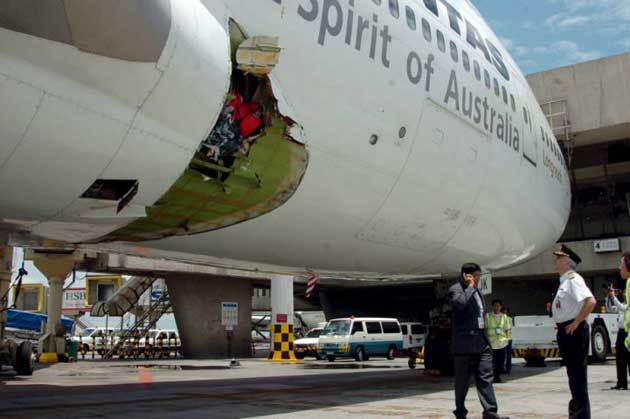Qantas chief denies holed jumbo was a 'rust bucket'

A Qantas jumbo jet forced to make an emergency landing in Manila with a "van-sized" hole in the fuselage had serious corrosion, it was claimed yesterday.
Entries on an online aviation forum going back to February revealed that rust had been found during a refurbishment of the 17-year-old aircraft. One of the posts spoke of "serious corrosion issues" that had delayed its launch date back into service.
"Let's keep our fingers crossed and hope OJK [the aircraft's identification] recovers from her plastic surgery," the forum writer added.
The allegations, which emerged as passengers from the 747-400 arrived in Melbourne yesterday, threatened further damage to the image of Australia's national airline, which is in the midst of a public relations disaster as film and photographs of the mid-air drama and the gaping fuselage circulate around the world.
Australian newspapers described the stricken jumbo as a "rust bucket", a claim vehemently denied by Qantas's chief executive, Geoff Dixon, who said reports of corrosion contributing to the incident should be discounted.
Mr Dixon said corrosion commonly occurred in some parts of all planes, but he insisted there was no evidence of it at the site of the hole in the fuselage.
Australia's Civil Aviation Safety Authority last night supported him. "Speculation in some quarters of corrosion found in the aircraft earlier this year can in no way be related to this accident," said its spokesman, Peter Gibson.
Australian investigators arrived in Manila yesterday to inspect the plane, which was left with a hole measuring about 6ft by 12ft in its fuselage, close to the wing.
The cause of the rupture is still unknown, although metal fatigue or an internal explosion caused by a pressurised container in a passenger's baggage have both been put forward as possible theories.
Relieved passengers arriving in Melbourne spoke of hearing a loud bang, which was followed by a gust of wind through the cabin and oxygen masks dropping from the ceiling.
One woman said part of the plane's flooring gave way, exposing the cargo area. As the plane lost altitude, passengers feared the worst.
David Saunders, of Melbourne, thought he was going to die. "The plane just started to dive, and I thought we were going down into the sea," he said. "I just grabbed my passport out of my bag and put it in my pocket, so that if my body was found they could identify it quicker."
Australian newspapers commended Captain John Bartels and his crew for saving the lives of more than 300 passengers. Qantas, which has never lost an aircraft, has one of the best safety records of any airline, but there have been serious incidents in recent years, including a mains power failure that forced a Qantas 747 to make an emergency landing in Bangkok in January. Recent cost-cutting in the quest for greater efficiency and higher profits has also led to questions about the impact on safety.
Join our commenting forum
Join thought-provoking conversations, follow other Independent readers and see their replies
Comments